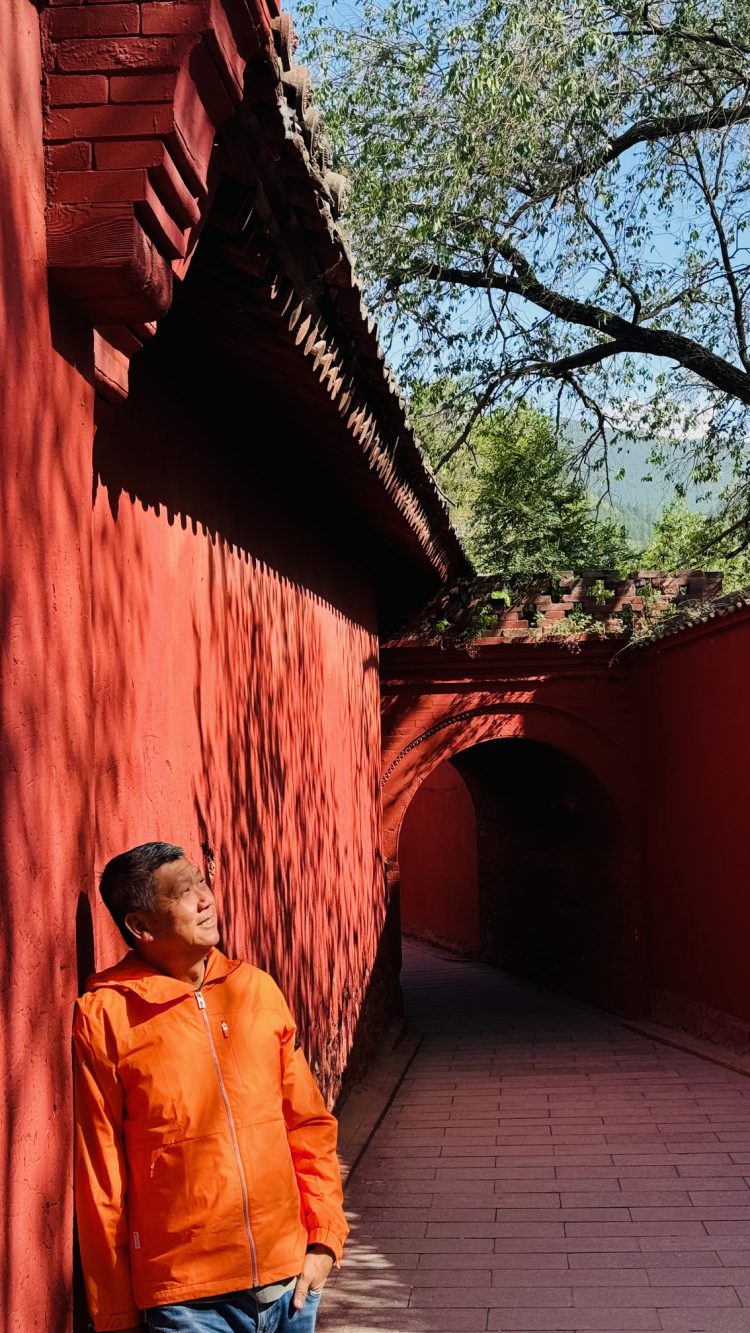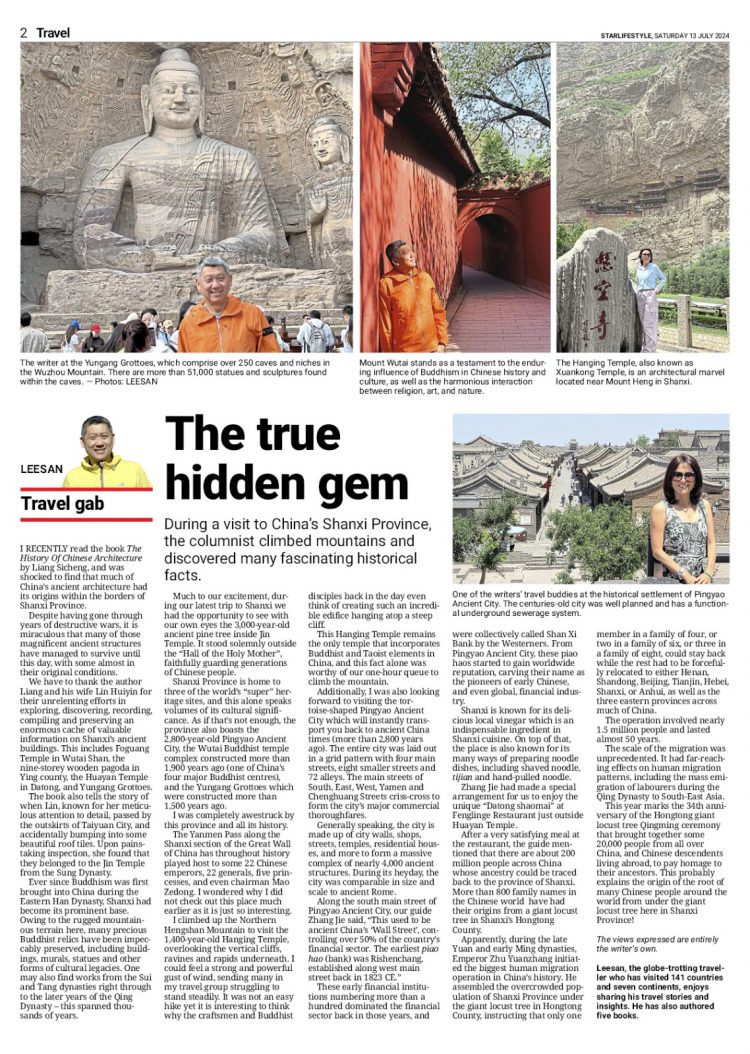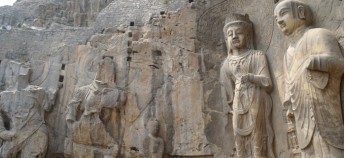The true hidden gem, Shanxi – by leesan
During a visit to China’s Shanxi Province, leesan climbed mountains and discovered many fascinating historical facts.
I RECENTLY read the book The HIstory of Chinese Architecture by Liang Sicheng, and was shocked to find that much of China’s ancient architecture had its origins within the borders of Shanxi Province.
Despite having gone through years of destructive wars, it is miraculous that many of those magnificent ancient structures have managed to survive until this day, with some almost in their original conditions.
We have to thank the author Liang and his wife Lin Huiyin for their unrelenting efforts in exploring, discovering, recording, compiling and preserving an enormous cache of valuable information on Shanxi’s ancient buildings. This includes Foguang Temple in Wutai Shan, the nine-storey wooden pagoda in Ying county, the Huayan Temple in Datong, and Yungang Grottoes.
The book also tells the story of when Lin, known for her meticu#lous attention to detail, passed by the outskirts of Taiyuan City, and accidentally bumping into some beautiful roof tiles. Upon pains- taking inspection, she found that they belonged to the Jin Temple from the Sung Dynasty.
Ever since Buddhism was first brought into China during the Eastern Han Dynasty, Shanxi had become its prominent base. Owing to the rugged mountainous terrain here, many precious Buddhist relics have been impeccably preserved, including buildings, murals, statues and other forms of cultural legacies. One may also find works from the Sui and Tang dynasties right through to the later years of the Qing Dynasty – this spanned thousands of years.
Much to our excitement, during our latest trip to Shanxi we had the opportunity to see with our own eyes the 3,000-year-old ancient pine tree inside Jin Temple. It stood solemnly outside the “Hall of the Holy Mother”, faithfully guarding generations of Chinese people.

The Hanging Temple, also known as Xuankong Temple, is an architectural marvel located near Mount Heng in Shanxi.

Leesan at the Yungang Grottoes, which comprises over 250 caves and niches in the Wuzhou Mountain. There are more than 51,000 statues and sculptures found within the caves.
Shanxi Province is home to three of the world’s “super” heritage sites, and this alone speaks volumes of its cultural significance. As if that’s not enough, the province also boasts the 2,800-year-old Pingyao Ancient City, the Wutai Buddhist temple complex constructed more than 1,900 years ago (one of China’s four major Buddhist centres), and the Yungang Grottoes which were constructed more than 1,500 years ago.
I was completely awestruck by this province and all its history. The Yanmen Pass along the Shanxi section of the Great Wall of China has throughout history played host to some 22 Chinese emperors, 22 generals, five princesses, and even chairman Mao Zedong. I wondered why I did not check out this place much earlier as it is just so interesting.
I climbed up the Northern Hengshan Mountain to visit the 1,400-year-old Hanging Temple, overlooking the vertical cliffs, ravines and rapids underneath. I could feel a strong and powerful gust of wind, sending many in my travel group struggling to stand steadily. It was not an easy hike yet it is interesting to think why the craftsmen and Buddhist.
disciples back in the day even think of creating such an incredible edifice hanging atop a steep cliff.
This Hanging Temple remains the only temple that incorporates Buddhist and Taoist elements in China, and this fact alone was worthy of our one-hour queue to climb the mountain.
Additionally, I was also looking forward to visiting the tortoise-shaped Pingyao Ancient City which will instantly trans- port you back to ancient China times (more than 2,800 years ago). The entire city was laid out in a grid pattern with four main streets, eight smaller streets and 72 alleys. The main streets of South, East, West, Yamen and Chenghuang Streets criss-cross to form the city’s major commercial thoroughfares.
Generally speaking, the city is made up of city walls, shops, streets, temples, residential houses, and more to form a massive complex of nearly 4,000 ancient structures. During its heyday, the city was comparable in size and scale to ancient Rome.
Along the south main street of Pingyao Ancient City, our guide Zhang Jie said, “This used to be ancient China’s ‘Wall Street’, controlling over 50% of the country’s financial sector. The earliest piao hao (bank) was Rishenchang, established along west main street back in 1823 CE.”

One of leesan’s travel buddies at the historical settlement of Pingyao Ancient City. The centuries-old city was well planned and has a functional underground sewerage system.

Mount Wutai stands as a testament to the enduring influence of Buddhism in Chinese history and culture, as well as the harmonious interaction between religion, art and nature.
These early financial institutions numbering more than a hundred dominated the financial sector back in those years, and were collectively called Shan Xi Bank by the Westerners. From Pingyao Ancient City, these piao haos started to gain worldwide reputation, carving their name as the pioneers of early Chinese, and even global, financial indus#try.Shanxi is known for its delicious local vinegar which is an indispensable ingredient in Shanxi cuisine. On top of that, the place is also known for its many ways of preparing noodle dishes, including shaved noodle, tijian and hand-pulled noodle.
Zhang Jie had made a special arrangement for us to enjoy the unique “Datong shaomai” at Fenglinge Restaurant just outside Huayan Temple.
After a very satisfying meal at the restaurant, the guide men- tioned that there are about 200 million people across China whose ancestry could be traced back to the province of Shanxi. More than 800 family names in the Chinese world have had their origins from a giant locust tree in Shanxi’s Hongtong County.
Apparently, during the late Yuan and early Ming dynasties, Emperor Zhu Yuanzhang initiat- ed the biggest human migration operation in China’s history. He assembled the overcrowded population of Shanxi Province under the giant locust tree in Hongtong County, instructing that only member in a family of four, or two in a family of six, or three in a family of eight, could stay back while the rest had to be forceful- ly relocated to either Henan, Shandong, Beijing, Tianjin, Hebei, Shanxi, or Anhui, as well as the three eastern provinces across much of China.
The operation involved nearly 1.5 million people and lasted almost 50 years.
The scale of the migration was unprecedented. It had far-reach- ing effects on human migration patterns, including the mass emi- gration of labourers during the Qing Dynasty to South-East Asia.
This year marks the 34th anniversary of the Hongtong giant locust tree Qingming ceremony that brought together some 20,000 people from all over China, and Chinese descendents living abroad, to pay homage to their ancestors. This probably explains the origin of the root of many Chinese people around the world from under the giant locust tree here in Shanxi Province!

Published in The Star, 13 Jun 2024
全球超过80000家酒店,Apple101助您轻松订房,出行无忧,绝对优惠价。入住期间付款,多数客房可免费取消!











